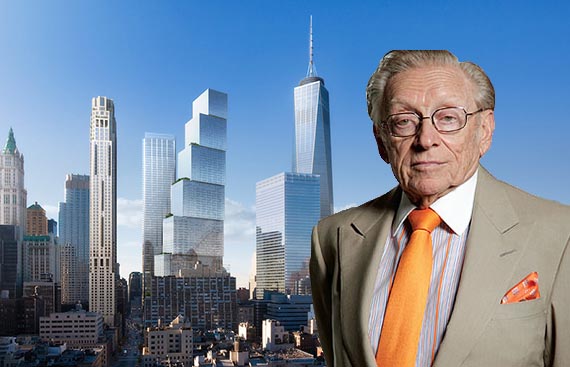Trending
Silverstein talks 2 WTC, languishing luxury market
Developer says he isn't worried about finding a new tenant

When Larry Silverstein saw the design for 2 World Trade Center, he did not respond positively, especially given the site’s history.
“My first reaction was, ‘Wow, this building looks like it’s going to topple. It’s going to fall over,’ ” the developer said during a panel Thursday on the 40th floor of another one of his buildings, 7 World Trade Center. The 84-year-old eventually warmed to Bjarke Ingels’ design — a series of stair-like boxes rising more than 80 stories tall — but in January, another crucial part of the building’s future fell apart. After 15 to 16 months of discussions, the building’s anchor tenant, News Corp., backed out.
“At the last moment, it was Rupert Murdoch who called and just let me know that they were concerned about the state of the world and the magnitude of the commitment that it would require if they were to go forward with the transaction,” Silverstein said. “He felt that the timing was bad from their vantage point.”
Silverstein reiterated previous assertions that it won’t take long for a replacement tenant to materialize. The building represents the “new language” of buildings in New York City and the creativity of its architect — qualities that will swiftly attract future occupants, he said.
“We’ll build tower two,” he said. “We will find a user for that building, and it won’t take up a lot of time. That’s a good building.”
During the Anchin Construction and Development Forum, Silverstein touched on other design decisions made over his career. He said that he has learned from many mistakes, including the original 7 World Trade Center, which ended up “a very pedestrian building,” due to the developer’s desire to save on construction costs.
“It was devoid of architectural quality, and amassed to a bulk of heaviness that was not what I really aspired to accomplish here, but I was intent on building as inexpensive as I could, and so that’s what we did,” he said. “But I learned as a result of that experience that it makes all the difference in the world to do first-class architecture because it will make all the difference in the world to prospective users.”
Silverstein, prompted by moderator Rosemary Scanlon, former dean of New York University’s Schack Institute of Real Estate, also touched on the slowing of the luxury condominium market. He said that the city has seen a tremendous influx of foreign capital, due to investors seeking a more secure market. But developers have been overzealous in their response to the demand, creating “five, six, maybe seven years” worth of supply in a very short period of time. As a result, activity in the ultra-luxury market “fell off the cliff,” he said.
“The flow has been incredible. It has made its way into the easiest form of hard asset acquisition. What is that? Condominium apartments.” he said. “What it’s caused, however, is an incredible movement in the condominium cycle, and what you have is a record number of condominium developments all over the city such that we suddenly find ourselves that the development community overdid it.”
Still, Silverstein said he doesn’t expect the flow of foreign investments to stop pouring into the U.S. anytime soon. It will just take some time for the overflow of luxury properties to be absorbed, he said.
As for new office buildings in the city, Silverstein believes there’s a lot of demand for modern office buildings. But he said his company, Related Companies and Brookfield Property Partners are the only developers pulling their weight in replacing the aging stock.
“Other than the three of us, there’s no creation of new office space certainly of any quantity or quality,” he said.




